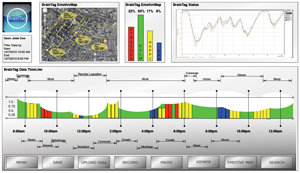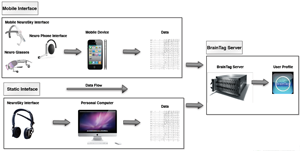How does Brain Tag work?
Diagram on the right shows an example of how the BrainTag API works with an online application interface. (Picture 1)
Let's imagine that the user in the top photo is listening to music on iTunes:
- As the user listens to music, his or her emotional response to the music is analyzed by their personal EEG device.
- This raw brainwave data is processed on the user's device before being sent to the BrainTag server as emotional data, both timestamped and locationaware
- While the application is running, the application's server accesses this timestamped information to find the user's response to the current media.
- The user's profile on the specific application's server is updated with a simplified version of the BrainTag data. In the case of iTunes, it would tag a song with information like "Mostly Sad" or "Extremely Happy".
- On the user's system, the song would be tagged with this information to allow easy access for creating smart playlists based on current mood.
- On the application's online server, the recommendation algorithm would process the user's new data to provide more specific recommendations in the future.
- On the BrainTag server, metadata is added to say that iTunes played a specific song at a time and location.
User Profiles
Every BrainTag user has their own user profile located on the BrainTag website. The BrainTag servers store all of the user's timestamped emotional data, while the user profile provides a convenient interface to interact with this data. (Picture 2)
- A map shows where the user has been that day, and how they felt at each location.
- Application pop-ups show what the user was interacting with at each location. For example, a user can see where his or her tweets occurred, or where Shazam identified a song that received a positive reaction.
The user can select a specific timeframe of data to view, and has the ability to enable filters that display only certain applications.
Devices
BrainTag requires an internet connection to function properly. Because of this, we have planned two types of devices:
- The home version is a larger unit combining headphones and an EEG device. This unit connects to your computer through a local WiFi connection.
- The portable devices place the EEG reader inside of common, fashionable accessories like sunglasses, Bluetooth headsets, and headbands. These devices connect to your cell phone through a Bluetooth connection.


